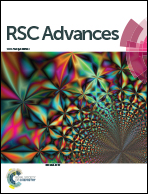Synthesis, crystal structure and photoluminescence of novel blue-emitting Eu2+-doped (SiC)x–(AlN)1−x phosphors by a nitriding combustion reaction†
Abstract
Novel blue-emitting phosphors with the chemical composition of (SiC)x–(AlN)1−x:yEu2+ (x = 0.06–0.50, y = 0.001–0.01) were synthesized by a nitriding combustion reaction route, and the crystal structure, luminescence properties and thermal stability of the (SiC)x–(AlN)1−x:yEu2+ phosphors were investigated by theoretical and experimental approaches. First-principles calculation results prove that the solid solution of SiC with AlN promotes the doping of Eu2+ ions into the (SiC)x–(AlN)1−x host lattice, and Eu2+ ions tend to occupy Al sites of the host. The synthesized (SiC)x–(AlN)1−x:yEu2+ phosphors absorb light in the region of 250–425 nm and show a single and symmetric broadband emission centered at about 470 nm due to the 4f65d–4f7 transitions of Eu2+. The luminescence intensity increases with the SiC content and reaches its maximum at x = 0.20. The critical quenching concentration of Eu2+ in the (SiC)0.20–(AlN)0.80:yEu2+ phosphor is about y = 0.006. The composition-optimized (SiC)0.20–(AlN)0.80:0.006Eu2+ phosphor shows a small thermal quenching, retaining the luminance of 91.1% at 150 °C. The CIE coordinates were measured as (0.135, 0.167) with high color purity. The above results indicate that (SiC)x–(AlN)1−x:yEu2+ is a promising candidate as a blue-emitting ultraviolet convertible phosphor for white LEDs, and the combustion reaction route is expected to be applicable to the synthesis of other kinds of nitride phosphors.


 Please wait while we load your content...
Please wait while we load your content...